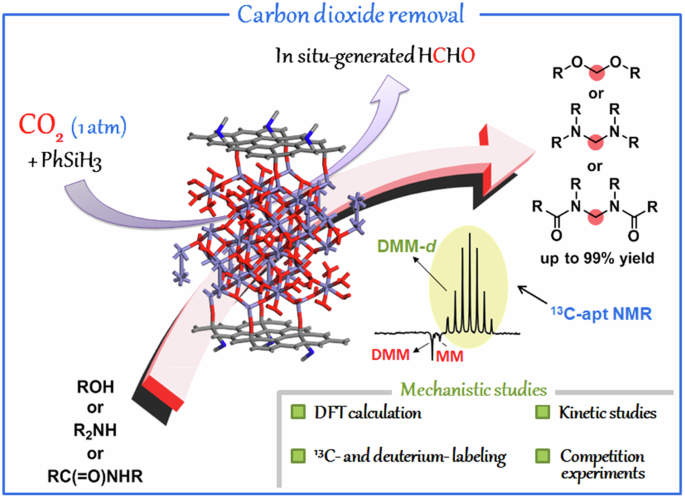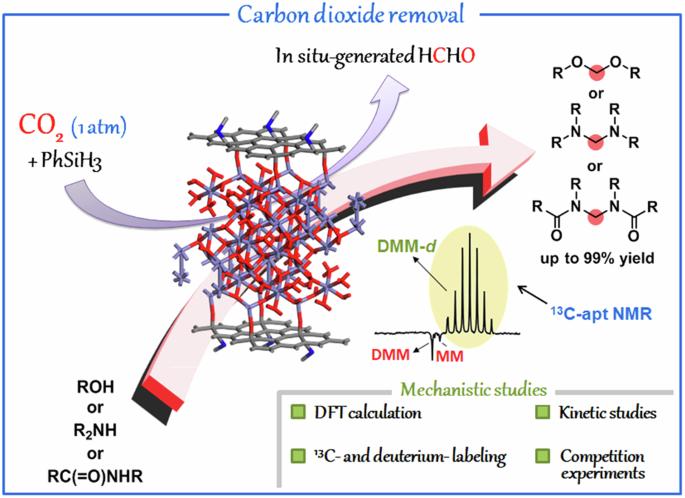使用铁功能化氧化石墨烯基催化剂将二氧化碳选择性还原转化为 CH2-桥接化合物
IF 7.5
Q1 MATERIALS SCIENCE, MULTIDISCIPLINARY
引用次数: 0
摘要
人为气候变化严重影响着我们的地球,而二氧化碳是最关键的气体驱动因素。尽管已有二氧化碳捕获和转化技术,但我们仍亟需具有优异选择性的创新型二氧化碳氢化催化剂。在此,我们提出了一种快速、有效、可持续的路线,通过在功能化氧化石墨烯(GO)上装饰天然金属基均相催化剂,将多种醇、胺和酰胺与二氧化碳进行异质化偶联。结合合成、实验和理论研究,我们揭示了在温和条件下实现 CO2 4 电子还原的机理路线。我们成功地用廉价、普遍可用且可回收的铁取代了有毒且昂贵的钌。这种铁基功能化氧化石墨烯(标记为 Fe@GO-EDA,其中 EDA 代表乙二胺)可作为一种高效催化剂,将 CO2 选择性地转化为甲醛氧化级,从而为利用 CO2 作为 C1 源的有趣分子结构打开了大门。总之,这项工作描述了一个有趣的异质平台,可通过 CO2 的 4 电子还原选择性合成有价值的亚甲基桥化合物。本文章由计算机程序翻译,如有差异,请以英文原文为准。


Selective reductive conversion of CO2 to CH2-bridged compounds by using a Fe-functionalized graphene oxide-based catalyst
Anthropogenic climate change drastically affects our planet, with CO2 being the most critical gaseous driver. Despite the existing carbon dioxide capture and transformation, there is much need for innovative carbon dioxide hydrogenation catalysts with excellent selectivity. Here, we present a fast, effective, and sustainable route for coupling diverse alcohols, amines and amides with CO2 via heterogenization of a natural metal-based homogeneous catalyst through decorating on functionalized graphene oxide (GO). Combined synthetic, experimental, and theoretical studies unravel mechanistic routes to convergent 4‑electron reduction of CO2 under mild conditions. We successfully replace the toxic and expensive ruthenium species with inexpensive, ubiquitously available and recyclable iron. This iron-based functionalized graphene oxide (denoted as Fe@GO-EDA, where EDA represents ethylenediamine) functions as an efficient catalyst for the selective conversion of CO2 into a formaldehyde oxidation level, thus opening the door for interesting molecular structures using CO2 as a C1 source. Overall, this work describes an intriguing heterogeneous platform for the selective synthesis of valuable methylene-bridged compounds via 4‑electron reduction of CO2. Carbon dioxide in the atmosphere can be captured and transformed to useful chemicals with hydrogenation catalysts. Here, iron-functionalized graphene oxide-based catalyst functions as an effective catalyst for the selective conversion of carbon dioxide into a formaldehyde oxidation level.
求助全文
通过发布文献求助,成功后即可免费获取论文全文。
去求助
来源期刊

Communications Materials
MATERIALS SCIENCE, MULTIDISCIPLINARY-
CiteScore
12.10
自引率
1.30%
发文量
85
审稿时长
17 weeks
期刊介绍:
Communications Materials, a selective open access journal within Nature Portfolio, is dedicated to publishing top-tier research, reviews, and commentary across all facets of materials science. The journal showcases significant advancements in specialized research areas, encompassing both fundamental and applied studies. Serving as an open access option for materials sciences, Communications Materials applies less stringent criteria for impact and significance compared to Nature-branded journals, including Nature Communications.
 求助内容:
求助内容: 应助结果提醒方式:
应助结果提醒方式:


